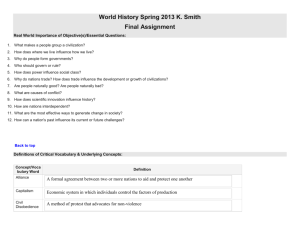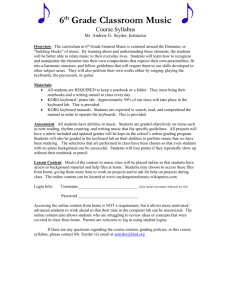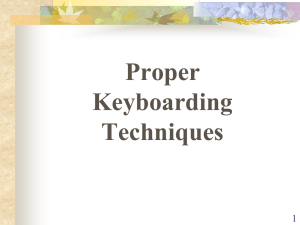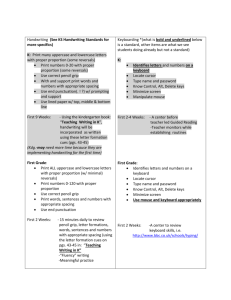AIU Assistive Technology Considerations Checklists
advertisement
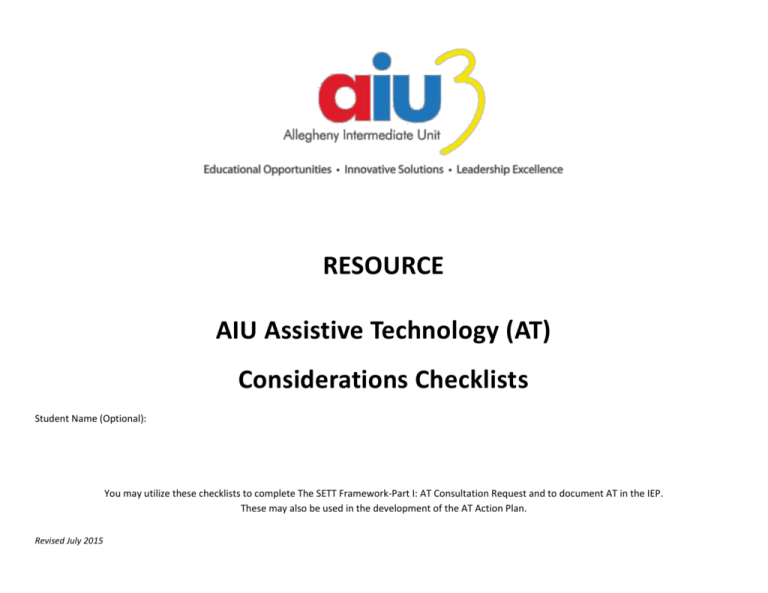
RESOURCE AIU Assistive Technology (AT) Considerations Checklists Student Name (Optional): You may utilize these checklists to complete The SETT Framework-Part I: AT Consultation Request and to document AT in the IEP. These may also be used in the development of the AT Action Plan. Revised July 2015 AIU Assistive Technology Considerations Checklists These are generic feature descriptions of AT options generally listed from no-high tech. AT Intervention for Communication Yes/no strategy for basic communicative needs Picture symbols Photos/digital pictures Use a communication board with pictures, text, or objects Symbol-authoring software to create boards/activities Eye-gaze frame with pictures or text Pen and paper to communicate with text or drawings Portable keyboard or computer to type messages during conversation Sign-assisted speech to enhance a student’s receptive communication Single-level, voice-output communication aid (VOCA) Multi-level, voice-output communication aid (VOCA) Voice-output communication aid (VOCA) with icon sequencing Voice-output communication aid (VOCA) with dynamic display Voice-output communication aid (VOCA) with synthesized speech Voice-output communication aid (VOCA) with automatic level switching Radio frequency identification (RFID) communicator with digitized speech Speech-generating device (SGD) Speech-generating device (SGD) with eye gaze interface Tablet device with a touch screen interface Switch to access and activate device when direct selection is not an option Keyguard for use of the communication device Carrying case for the communication device Stylus or T-stick to activate the communication device External speakers/speaker case to amplify sound for listeners External headphones Additional battery, charger, and/or AC power cord Revised July 2015 2 AT Intervention for Computer Access OS-level accessibility options for keyboarding (e.g., Sticky Keys, repeat rate) Abbreviation expansion (AutoCorrect or Replace) to reduce keystrokes AutoText to reduce keystrokes Word prediction to reduce keystrokes or assist spelling and word use Keyguard to assist users in making direct selections Arm or chair supports to promote proper positioning Track ball, joystick, or other alternative mouse in place of a standard mouse Touchscreen monitor as an alternative input device Keytop overlays to label keys in both cases Keytop overlays to promote finger positioning/hand use Onscreen keyboard for typing Alternate keyboard or keyboard layout Head mouse or pointer to type on an onscreen or standard keyboard Switch as a primary input device Switch interface for multiple switches and functions Scanning (auditory, step, radial, etc.) as a means of input Voice recognition software as a primary means of input AT Intervention for Mathematics Graph paper for spacing or alignment Formatted paper (e.g., guideline papers formatted for an algorithm) Vertically lined paper to aid alignment/place value Abacus or math line for calculations Enlarged work materials (for clarity or spacing) Calculator or coinulator for computation activities Calculator that is capable of printing results Calculator with speech output capability Calculator with enlarged keys or displays Measurement tools that feature tactile guides Measurement tools with speech output capability Math notation software as an alternative to pencil-and-paper Drawing or graphing software as an alternative to pencil-and-paper Virtual manipulatives to provide an access alternative to physical ones Revised July 2015 3 AT Intervention for Organization Print, picture, or tactile schedule Color-coding- to organize books, folders, and other materials Markers, removable tape, or acetate line guides to highlight text Recorded messages to prompt student behaviors or tasks Paper organizers for assignments and tasks Electronic organizers/software for assignments and tasks Hand-held computers (PDAs) or a tablet device with a touch screen interface for assignments, tasks, and productivity Use software to generate graphic organizers (concept development or organization) AT Intervention for Reading Predictable books to assist in decoding & comprehension Decodable text Styles to maximize accessibility of word-processed documents among potential users Reading guides/windows Scoptic (colored filter) overlays Altered word spacing Altered line spacing Altered text size or color Symbol-writing software to pair text with symbols or pictures Electronic tool for pronunciations, spellings, or meanings Single-word/line scanners to read text aloud Audio books to supplement printed text Audio books to replace printed text Text-to-speech software to read typed text aloud Digital imaging software to digitize documents Optical character recognition (OCR) software to digitize and manipulate text Scan-and-read software to access and annotate text Books adapted for independent page-turning Electronic books to allow for easy magnification/transportation DAISY-formatted text and readers (may be subject to eligibility requirements) NIMAS file sets (subject to eligibility requirements) Revised July 2015 4 AT Intervention for Seating and Positioning Adjustable chair Adjustable desk or workstation Foot rest or stool Solid wedge to promote back extension Lordosis roll to support back and provide extension Tactile cushion Chair with armrests or supports Supportive chair (e.g., Rifton, Kaye, Thera-Adapt, Lecky) Chair with additional supports (e.g., laterals, headrest, hip abductor, pelvic belt, chest harness) Tray or table-top support Chair with tilt/recline capabilities Modified work tray, table, or work station Mounting system (e.g., desktop, rigid, swing-away, folding) AT Intervention for Sensory Needs Open-captioned materials Closed-captioned materials Personal amplification devices (personal FM, infrared system) Real-time captioning or computer-assisted real time (CART) to transcribe lectures or discussions Computer-aided notetaking systems OS-level accessibility options for audible/visual messages Handheld or stationary magnifiers Large-print materials Braille materials for reading (or labels on keyboards) Raised-line materials Tactile graphics Adjusted screen contrast for improved visibility Screen magnification software or hardware for monitor visibility Screen reading software for access to onscreen content Braille translation software with an embosser or refreshable Braille display Closed-circuit televisions for magnification/contrast Video magnifier for magnification/contrast and near/distant viewing Revised July 2015 5 AT Intervention for Writing Adaptive or alternative grips, pencils, and pens Harder/softer lead weight to result in lighter/darker line Non-slip surfaces or clipboards to stabilize materials Adapted paper (e.g., graph paper, raised-line paper, or highlighted-line paper) to assist with spacing and organization Adjusted seat and/or desk heights for adequate posture and support Slantboard for optimal writing angle List of prewritten words/phrases Graphic organizer to structure ideas and content Cloze notes to reduce the amount of material to be written Access to full notes as a back-up to student-generated notes Scribe services when there is no independent means for a student to record notes or ideas Analog or digital recording device to record lectures/commentary Printed labels to provide legible answer choices Label machine to generate legible answers independently Video pen and paper to capture notes and/or recordings Portable keyboard Portable keyboard with text-to-speech capability Access to a desktop, laptop, netbook, or tablet computer Spelling and grammar checker Word prediction software Text-to-speech software to provide audible reinforcement Digital imaging (scanning) software to annotate scanned documents Scan-and-read software to annotate and manipulate contents of scanned documents Grid-based word processor for composition Cloze-style word processor for notetaking or assessment purposes Speech recognition software for extensive writing tasks AT Interventions – Additional Revised July 2015 6
